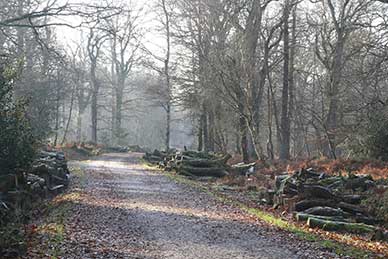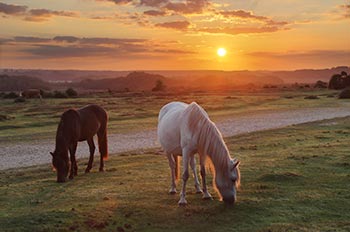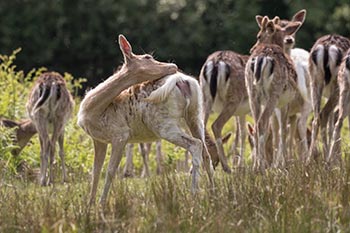Broad-leaved inclosures

Wander amongst oak and beech in one of the New Forest’s broad-leaved woodland inclosures, savour the experience and consider that these New Forest woodlands were originally created to supply timber for the Navy, timber with which would be built the ships so important to the British Empire.
Walk through other New Forest woodland inclosures, through South Bentley and Burley Old Inclosures, woodlands first planted in the reign of Queen Anne, more than 300 years ago. Then visit Holly Hatch, Ironshill and Set Thorns Inclosures, all first laid down whilst Napoleon waged war in Europe.
Not all the original trees remain, of course, and in places, few can still be seen. But time has largely been kind, endowing on these woods some of the variety initially missing from the neatly ordered rows.
Winter gales, damp and fungi have done their work. Fallen giants of yesteryear have created mini-clearings in which brambles often thrive, and dead and decaying timber can now be found, creating living space for birds, bats and invertebrates.
Active management is also undertaken in many of these woods.
Non-native and 'pest' species of trees and shrubs - Turkey oak, rhododendron, sycamore and Scots pine, for example - are often systematically removed or controlled where they present an invasive threat to the natural ecology.
Selective felling of native species is also undertaken so as to increase woodland diversity and benefit wildlife - additional space created between standing trees helps those that remain ‘grow-on’, spreading their crowns and creating new or modified places in which wildlife can live.
Clearings are introduced and increased light reaches the woodland floor, encouraging the growth of wild flowers, which attract insects, including a range of butterflies. Some bird species prefer the newly created space, rather than the denser parts of the wood, and many bat species like space in which to fly, free of the clutter that might otherwise interfere with their sophisticated echo-location systems.
Then, whilst some of the felled timber is sold as part of the New Forest’s commercial forestry operation, some is also left to lie and decay as another useful resource for wildlife.
Original plantings were most often of oak and beech, but other species have since colonised, or been introduced: sweet chestnut, ash, rowan, blackthorn, hawthorn, occasional ornamental conifers and more, all adding wonderful diversity to these beautiful woods.
Autumn, when the trees are ablaze with gold and crimson, is the most colourful time of year to visit New Forest woodland, and offers also the prospect of witnessing the awesome power of rutting fallow bucks.
Fresh, pale green springtime foliage is, though, just as attractive; whilst summer offers peace and quiet in shaded glades, and the sight of butterflies flitting along woodland rides. Even winter has its joys - the trees stripped bare of leaves better reveal woodland birds high above.
Woodpeckers will be prominent amongst the New Forest' woodland inhabitants, both the often conspicuous great spotted woodpecker and also its smaller cousin, the tiny lesser spotted woodpecker. The ringing cries of nuthatches are often present, whilst tits, treecreepers and chaffinches roam in often large, loose flocks.
Jays, bramblings and chaffinches feasting on autumnal corns and beech mast will be joined by grey squirrels whose agile antics never cease to entertain.
Deer, too, enjoy the autumn’s harvest. Unless tall inclosure fences prevent access, roe and fallow deer are likely to be present; whilst to the south of railway line, a little to the east of Brockenhurst, sika deer may also be seen. But if the animals evade observation, notice at least the signs of deer presence: slots in the mud, droppings, and mini hollow-ways below the botton strand of wire fences - deer ‘creeps’ used as these animals pass from place to place.
Commoners’ stock are often excluded from the New Forest woodland inclosures, for their presence threatens the survival of many wild flower species - such as bluebells, wood anemones, wood sorrel, violets, honeysuckle and brambles - that when able to avoid the attentions of the stock and deer, sometimes grow in reasonable numbers.
And where there are wild flowers, and brambles in particular, butterflies will be found, often in good numbers. Ringlets are common and so are brimstones, gatekeepers, skippers, peacocks, commas, red admirals and speckled wood butterflies.

silver-washed fritillary
White admirals are also widespread in some years, whilst July visitors will almost certainly see silver-washed fritillaries. Gorgeous, deep, rich orange insects, they are Britain’s largest fritillary. Watch as they pass along woodland rides in a series of swoops and glides, stopping every so often to take nectar and pollen from the bramble’s blooms.
In season, dragonflies, too, patrol, often well away from water, flying back and forth on gossamer wings along short stretches of path claimed as their own, all the while hunting for insect prey – golden-ringed dragonflies, common darters and southern hawkers are the ones most often seen.
Enjoy access, then, to these New Forest woodland inclosures, and explore the many miles of sheltered tracks and grassy rides, for every season has a beauty all its own.
And who knows what is around the next corner, as the New Forest’s wild inhabitants go quietly about their daily business.
(Add yet more interest to woodland walks - information about the fascinating history of these marvellous places is here: New Forest Inclosures).
Quick linksMore links
Other related links
Search this site

Sadly, 58 animals were killed - 35 ponies, 13 cows, 8 donkeys and 2 sheep, whilst a further 32 were injured - 3 pigs, 9 donkeys, 11 cows and 9 ponies.
(Forty-three accidents occurred in daylight, 15 at twilight and 101 in the dark. Twenty-seven accidents were not reported by the driver involved).
Here's just one horrific example - Three donkeys killed in collision with van at notorious New Forest blackspot (Advertiser and Times)


Sika deer continue to engage in rutting behaviour, and will do so until December.
Pigs seek out the remains of the acorn crop.
Beech leaves are transformed into a magnificent mosaic of glorious reds and golds. Other deciduous trees, too, take on an autumnal cloak before their leaves fall.
Dragonflies can occasionally be seen on the wing on bright days early in the month.
December
Foxglove leaves survive the winter at ground level, and offer the prospect of colourful summer blooms to come.
Redwings and fieldfares, autumn and winter visitors, gorge on haws and holly berries.
Great grey shrikes and hen harriers hunt over the heaths and other open spaces.
Honeysuckle by the end of the month often shows welcome signs of new growth.

